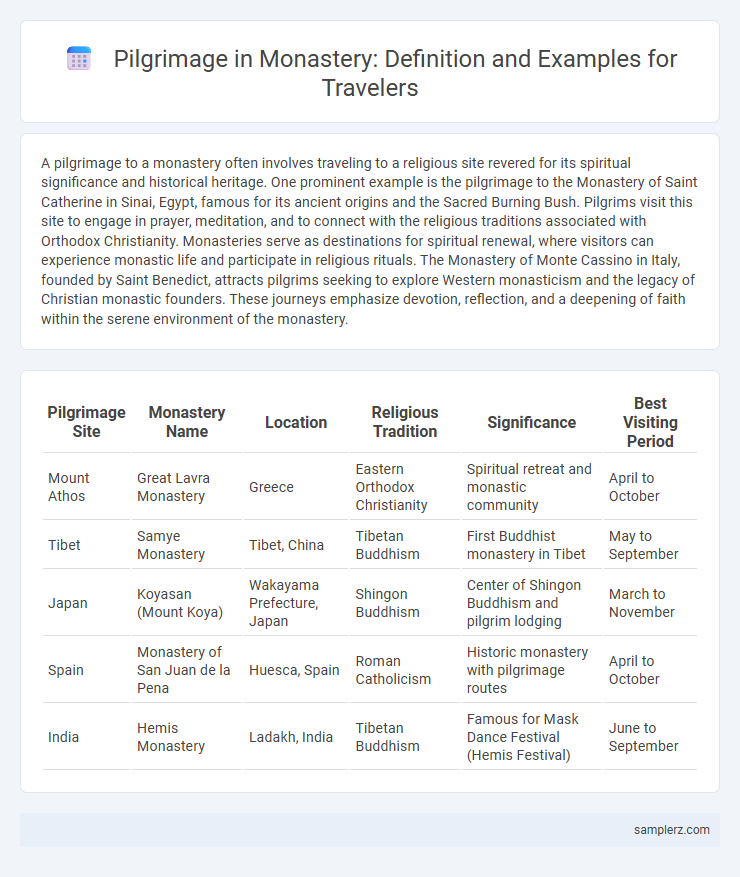A pilgrimage to a monastery often involves traveling to a religious site revered for its spiritual significance and historical heritage. One prominent example is the pilgrimage to the Monastery of Saint Catherine in Sinai, Egypt, famous for its ancient origins and the Sacred Burning Bush. Pilgrims visit this site to engage in prayer, meditation, and to connect with the religious traditions associated with Orthodox Christianity. Monasteries serve as destinations for spiritual renewal, where visitors can experience monastic life and participate in religious rituals. The Monastery of Monte Cassino in Italy, founded by Saint Benedict, attracts pilgrims seeking to explore Western monasticism and the legacy of Christian monastic founders. These journeys emphasize devotion, reflection, and a deepening of faith within the serene environment of the monastery.
Table of Comparison
| Pilgrimage Site | Monastery Name | Location | Religious Tradition | Significance | Best Visiting Period |
|---|---|---|---|---|---|
| Mount Athos | Great Lavra Monastery | Greece | Eastern Orthodox Christianity | Spiritual retreat and monastic community | April to October |
| Tibet | Samye Monastery | Tibet, China | Tibetan Buddhism | First Buddhist monastery in Tibet | May to September |
| Japan | Koyasan (Mount Koya) | Wakayama Prefecture, Japan | Shingon Buddhism | Center of Shingon Buddhism and pilgrim lodging | March to November |
| Spain | Monastery of San Juan de la Pena | Huesca, Spain | Roman Catholicism | Historic monastery with pilgrimage routes | April to October |
| India | Hemis Monastery | Ladakh, India | Tibetan Buddhism | Famous for Mask Dance Festival (Hemis Festival) | June to September |
Famous Monastic Pilgrimage Destinations Worldwide
Mount Athos in Greece, renowned for its ancient Orthodox monasteries, attracts thousands of pilgrims annually seeking spiritual enlightenment and monastic traditions. The Monastery of Saint Catherine in Sinai, Egypt, houses one of the world's oldest Christian libraries and draws visitors aiming to connect with biblical history. In Tibet, the Tashi Lhunpo Monastery serves as a significant pilgrimage site for followers of Tibetan Buddhism, emphasizing meditation and religious study.
Historical Overview of Monasteries as Pilgrimage Sites
Monasteries have long served as significant pilgrimage sites, attracting devotees seeking spiritual solace and historical connection. Sites such as the Monastery of Montserrat in Spain and the Shaolin Monastery in China exemplify centuries-old traditions where religious, cultural, and architectural heritage intertwine. These monasteries preserve ancient relics and manuscripts, offering pilgrims a tangible link to sacred history and enduring faith.
Spiritual Significance of Pilgrimage in Monastic Traditions
Pilgrimage to monasteries such as Mount Athos in Greece or the Tiger's Nest Monastery in Bhutan holds profound spiritual significance, symbolizing a journey of inner purification and devotion. Monastic pilgrimage serves as a sacred act to seek divine blessings, deepen meditation, and embrace ascetic discipline in serene, spiritually charged environments. These journeys foster connection with centuries-old monastic traditions, cultivating spiritual growth and enlightenment through contemplation and prayer.
Iconic Monastic Pilgrimage Routes to Experience
The Camino de Santiago in Spain remains an iconic monastic pilgrimage route, drawing travelers to its historic monasteries and the Cathedral of Santiago de Compostela. Mount Athos in Greece offers a unique spiritual experience with its ancient monasteries accessible only to male pilgrims, preserving Byzantine traditions. The Monastery of St. Catherine in Sinai, Egypt, is renowned for its ancient Christian heritage and sacred sites, attracting pilgrims seeking both religious and cultural enrichment.
Daily Life of Pilgrims in Monastic Retreats
Pilgrims in monastic retreats follow a structured daily routine centered on prayer, meditation, and communal meals within the monastery's serene environment. Activities include attending multiple prayer services, participating in silent reflection periods, and engaging in simple chores, fostering spiritual growth and discipline. The immersive experience emphasizes mindfulness, detachment from worldly distractions, and connection with the monastic community.
Authentic Experiences: Staying at Monasteries During Pilgrimage
Staying at monasteries during pilgrimage offers an authentic experience deeply rooted in spiritual tradition and cultural immersion. Pilgrims can participate in daily prayers, meditate in serene environments, and embrace the simplicity of monastic life, enhancing their journey beyond sightseeing. This unique accommodation choice fosters introspection and connection to the pilgrimage's historical and religious significance.
Unique Rituals and Ceremonies in Monastic Pilgrimages
Monastic pilgrimages often feature unique rituals such as the chanting of ancient hymns and the lighting of butter lamps at Tibetan monasteries, symbolizing enlightenment and spiritual renewal. Pilgrims engage in circumambulation, a meditative practice walking clockwise around sacred structures to accumulate merit and purify negative karma. These ceremonies serve as transformative experiences rooted in centuries-old traditions, deeply connecting participants to the monastic community and their spiritual heritage.
Inspiring Pilgrimage Stories from Monastic Journeys
Countless pilgrims have found profound spiritual renewal during monastic journeys, such as the annual trek to Mount Athos in Greece, where visitors immerse themselves in Orthodox Christian traditions. Stories from monasteries like St. Catherine's in Sinai reveal transformative experiences of silence, prayer, and ancient rituals that deepen faith and self-awareness. These inspiring pilgrimage tales illustrate the enduring power of monastic settings to foster inner peace and enlightenment.
Preparing for a Pilgrimage to a Monastery: Essential Tips
Preparing for a pilgrimage to a monastery requires careful planning of itinerary, packing appropriate clothing that respects the monastery's dress code, and arranging transportation to often remote locations. Pilgrims should research the monastery's schedule for prayers and rituals to fully engage in the spiritual experience while respecting local customs. Essential items include comfortable walking shoes, a reusable water bottle, and any personal meditation or prayer materials to enhance the visit.
Impact of Monastic Pilgrimage on Local Communities
Monastic pilgrimages attract thousands of visitors annually, boosting local economies through increased demand for lodging, food, and artisanal goods. These spiritual journeys foster cultural exchange, preserving traditional crafts and promoting community cohesion around monastic heritage sites. The influx of pilgrims also incentivizes infrastructure improvements, enhancing transportation and public services for residents and tourists alike.

example of pilgrimage in monastery Infographic
 samplerz.com
samplerz.com